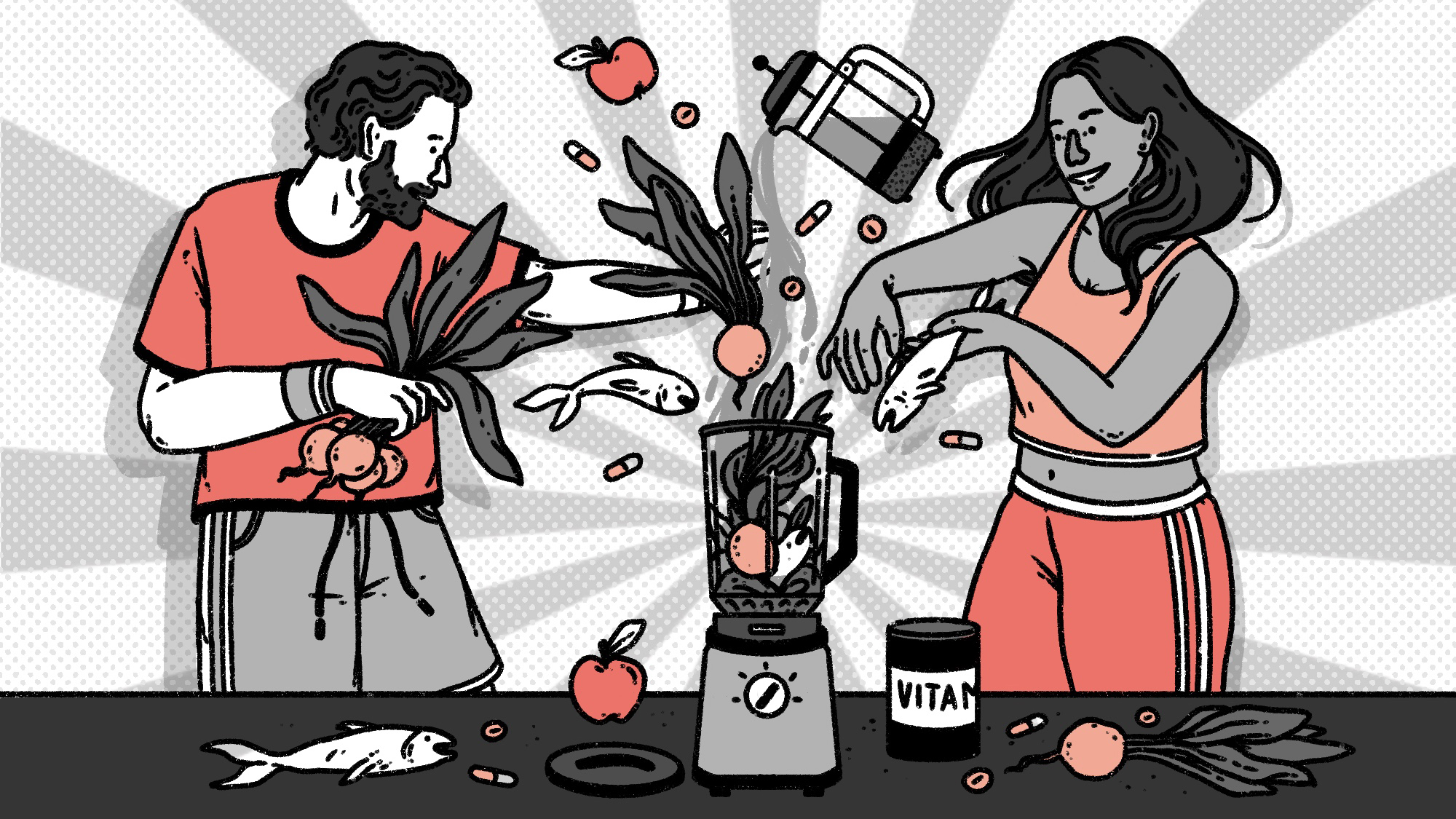DO YOU HAVE a big tub of pre-workout powder sitting close by? Look at the label. How many ingredients do you recognize?
Protein used to be the “it factor” in fitness supplements. But these products, sometimes called “pre-workouts,” have tweaked their recipes in the past decade. “One new trend is the increasing caffeine content,” says Andrew Jagim, director of sports medicine research at Mayo Clinic Health System in Wisconsin. In 2019, he and two other experts analyzed the chemical contents of 100 widely available pre-workout powders, vitamin supplements, and drinks to understand how consuming them might affect the average exercising adult. While the breakdown hasn’t changed much in the past four years, Jagim thinks some labels are more transparent now. “Historically, companies have listed their ingredients as proprietary blends,” he explains. “From the consumer’s perspective, they didn’t know how much of the ingredients they were getting.”
In general, Jagim says it’s safe to take one serving of a pre-workout before hitting the gym. The bigger question is whether the supplements really up your stamina, strength, and total fitness game. Let’s take a look at some of the helpers.
Beta-alanine
This protein builder counters muscle fatigue and soreness, letting you exercise harder and longer. But you have to take the right amount to feel the effect. In their study, Jagim and his team found that most pre-workouts contain around 2 grams of beta-alanine per serving—half of the recommended daily dose for adults.
One word of caution: Ingesting more than 4 grams, or even 2 to 3 grams for some people, of beta-alanine at a time could lead to a tingling effect known as paraesthesia. There have even been reports of gastrointestinal distress, dizziness, and symptoms similar to anxiety after taking it on an empty stomach. Taking a lower dose, splitting it throughout the day, or consuming a different form (like a pill instead of powder) might ease any bad reactions.
Caffeine
As any coffee or Red Bull fiend knows, caffeine gets you into a hyperexcited state by raising your heart rate, respiration, and blood flow. In other words, it warms up your body before you pop a single jump squat. It also fuels you throughout your workout, metabolizing slowly as your blood moves from the digestive organs to the central nervous system and muscles. Caffeine’s energizing effects are mainly caused by its interactions with the nervous system. They’re strongest 30 to 60 minutes after consumption and subside after another hour or two.
Most pre-workouts contain 250 to 300 milligrams of caffeine—equivalent to one to two cups of coffee. That falls under the daily 400- to 600-milligram limit recommended by the Food and Drug Administration (FDA). But if you’re getting the same stimulant from other sources—energy drinks, soda, lattes with extra espresso shots—you might go overboard. “If you have anxiety or underlying heart problems, it can complicate issues,” Jagim says. He also cautions against giving highly caffeinated pre-workouts, or any caffeine, to kids younger than 16, and against taking them in the evening in case they make it harder to fall asleep.
Creatine
This coveted ingredient contains three nonessential amino acids that are naturally found in the human body, fish, and red meat. A main fuel source for muscles, creatine has all kinds of positive health effects, many of which have been well studied, Jagim says. For starters, it helps prevent muscle cramps, repairs torn tissue, and builds mass after intense interval training and heavy lifting.
Many pre-workout products fall short of athletes’ creatine needs. On average, Jagim and his team measured 2.1 grams of the muscle-making additive, compared to the minimum of 3 grams recommended per day through diet and supplements. So what else is in these mixes?
Dimethylamylamine
A chemical that’s probably not listed on your pre-workout could be in it anyway. Dimethylamylamine (DMAA) is like a supercharged version of caffeine: It comes from amphetamines, a potent class of drugs that can be misused and result in addiction. The stimulant was often added to fitness supplements until the FDA classified it as a controlled substance in 2013. But some companies still slip in small amounts to get an edge over competitors, Jagim says. You shouldn’t be afraid of accidental “doping”—reports of bad DMAA side effects from pre-workouts are rare. Just avoid products on the FDA’s warning list for health violations.
If you’re still worried about what’s in your pre-workout and how it will affect you, look up the ingredients on a website reviewed by medical experts like examine.com, read the supplement fact label, and check if the item has a third-party certification seal. Or follow Jagim’s DIY approach and mix together three to four items (creatine powder, Greek yogurt, soy protein, or even cold brew) that fit your body’s needs. A store-bought supplement will probably do more good than harm, but in the end, you might spend more than it’s worth.
Read more in the Workout 360 series: the best basic routine, the muscles you forgot, and post-workout soreness. Or check out these other PopSci+ stories.

